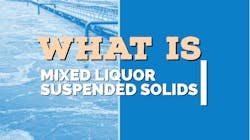Mixed liquor suspended solids (MLSS) is the suspended solids in the mixed liquor of an aeration tank. Mixed liquor is the mixture of the chemical components from the wastewater and the microbial components from the activated sludge. Suspended solids are the solids found in the liquor that do not dissolve but are dispersed throughout the liquid.
Formula for MLSS
MLSS can be calculated using this formula:
MLSS (mg/L) = weight of suspended solids in the aeration tank (mg) ÷ volume of the aeration tank (L)
MLSS is not be confused with mixed liquor volatile suspended solids (MLVSS), which is a different terminology also used in wastewater treatment.
Mixed liquor volatile suspended solids (MLVSS)
Mixed liquor volatile suspended solids (MLVSS) refers to the amount of organic or volatile suspended solids used as a measure or indication of the quantity of microbes present in the wastewater treatment.
MLVSS formulae
MLVSS is calculated using these formulae:
MLVSS (mass) = COD added to the aeration ÷ F/M ratio
MLVSS (concentration) = MLVSS (mass) ÷ V x 8.34 x 10-6
Where:
- COD = Chemical oxygen demand
- F/M = ratio of the amount of digestible organic matter to the amount of microorganisms
- V = volume of the aeration tank
The COD is the amount of oxygen that can be oxidized and is required in the mixed liquor. COD is related to biological oxygen demand (BOD) which is the concentration of oxygen needed by the aerobic bacteria to break down the organic matter.
The F/M ratio is usually between 0.3 and 0.6 and it varies depending on the organic load in the wastewater treatment process.
The difference between TSS and MLSS
Total suspended solids (TSS) is the measure of the total solids in water or wastewater samples. TSS is an important water quality parameter because if it is not removed as per regulations, high concentrations of TSS can occur in the receiving water.
TSS absorbs light and this can cause increased water temperature in the water body and decreased oxygen, which in turn can negatively affect the health of aquatic life. The National Pollutant Discharge Elimination System (NPDES) permit regulates TSS which applies to all Publicly Owned Treatment Works and this value is 30 mg/L for a 30 days average.
Why is MLSS important?
MLSS consists of suspended solids (both inorganic and organic) and microorganisms involved in the activated sludge process. The activated sludge process is integral to wastewater treatment. MLSS is an operational control parameter and for best treatment results, it needs to be optimized.
What affects the efficiency of the activated sludge process?
The MLSS value is affected by the health of the activated sludge. Factors that affect the efficiency of the activated sludge process include aeration, F/M ratio, pH and temperature of the water, and also nutrients in the water.
Other factors include poor flocculation — also referred to as floc — formation. Floc formation due to microorganisms is required for activated sludge treatment where gravity clarifiers are used. Poor floc formation can result in a turbid environment.
Toxic shock can be a serious problem in activated sludge operation in small communities and one of the causes is the overloading of small systems with septage containing a high amount of microbially-toxic organic acids and sulfides.
Other factors include nitrification in industrial wastewater systems where ammonia is present. Warmer temperatures and microbial growth can cause nitrification. This in turn can cause alkalinity. Denitrification can also occur when microorganisms in the activated sludge use nitrate when oxygen is lacking and release nitrogen gas as a by-product.
All of these factors are interlinked with each other. Poor aeration could cause low F/M ratio that could affect the pH of the water. The turbidity caused by unsettled solids and microorganisms affects the temperature, BOD, and thus, the availability of nutrients in the water. The overall result? Impaired wastewater treatment and possibly in violation of the regulations including the NPDES permit.
What happens if MLSS is too low or too high?
Lower and higher MLSS values are indicative of treatment issues in the wastewater treatment plant. Lower MLSS indicates lower dissolved oxygen and therefore, the survival of fewer microorganisms that depend on this oxygen for survival. It causes the buildup of light-colored foam on the surface of the aeration tank.
On the other hand, higher MLSS is indicative of excessive solids due to high BOD. It causes thick, dark-colored foam which contains unsettled solids. Higher MLSS typically occurs in winters due to low ambient temperatures. Higher MLSS can cause potentially high thickness of the sludge blanket that could indirectly lead to poor effluent quality.
Optimizing MLSS in wastewater treatment
In a traditional wastewater treatment plant with activated sludge, the typical optimal MLVSS to MLSS ratio is between 0.7 and 0.8 while the MLSS concentration ranges from approximately 1,500 mg/L to 5,000 mg/L.
Reducing the F/M ration could help solve the issues with floc formation whereas inorganic nitrogen can avoid the nitrification and denitrification issues.
The most important criteria for optimizing MLSS in wastewater treatment is to promote the activated sludge process. This includes maintaining the sludge volume, the thickness of the clarifier blanket, dissolved oxygen level, and the pH of the mixed liquor.
About the Author
Saleha Kuzniewski
Saleha Kuzniewski, Ph.D. has authored several publications in the fields of scientific research, biotechnology, and environmental regulations. She is the winner of the 2023 Apex award for publication excellence. She is also the founder of Environmental Remediation & Innovations, LLC. Kuzniewski can be reached at [email protected].

